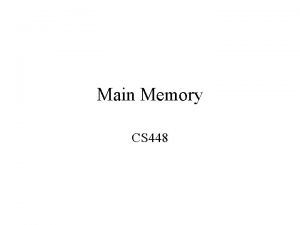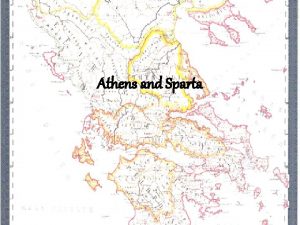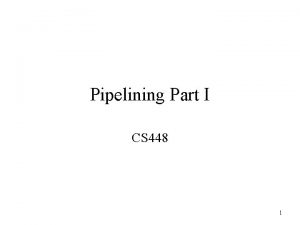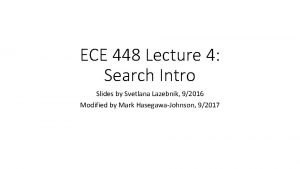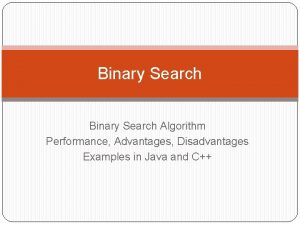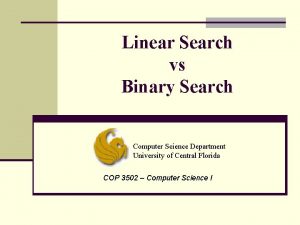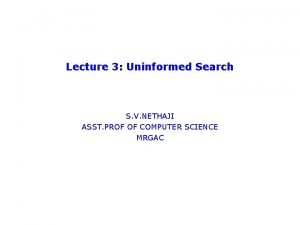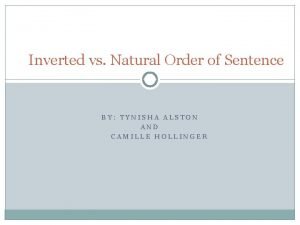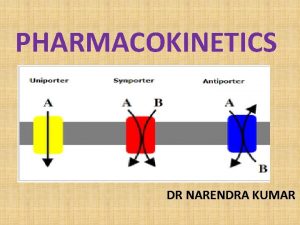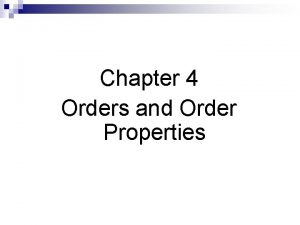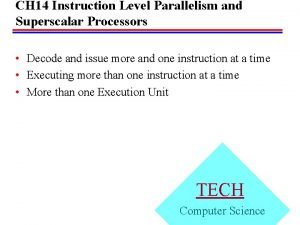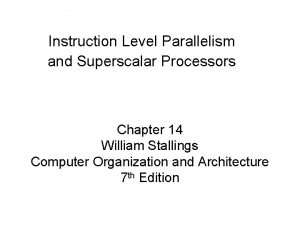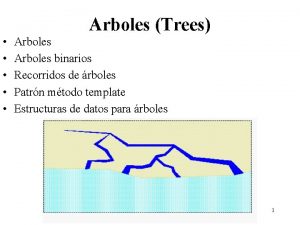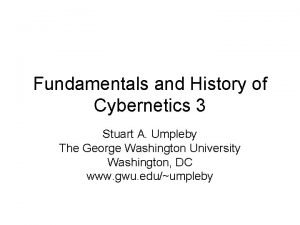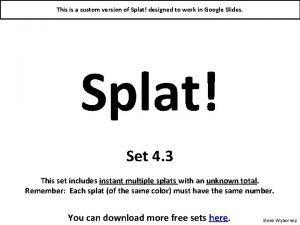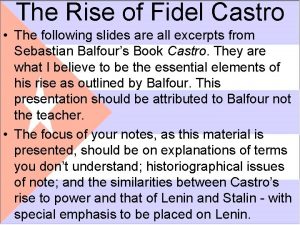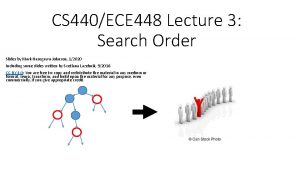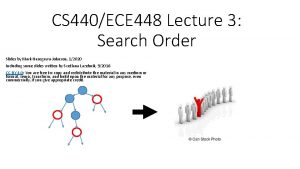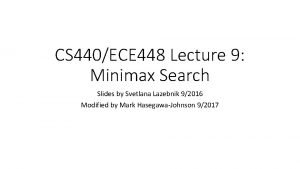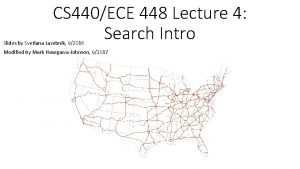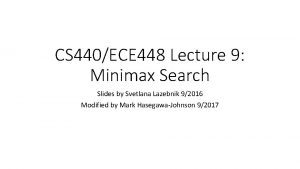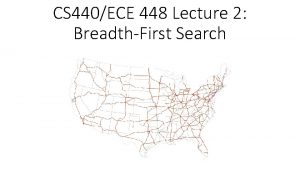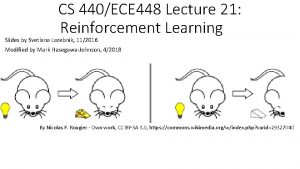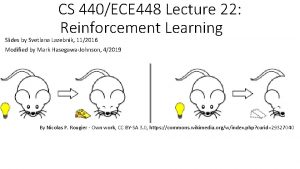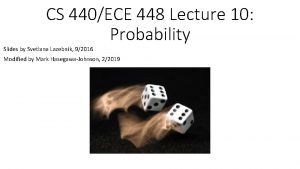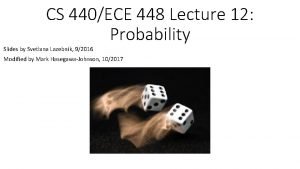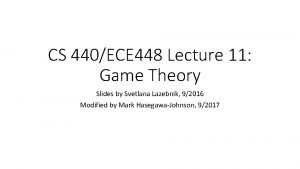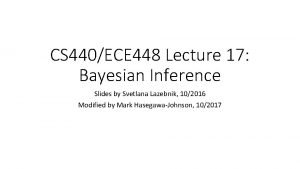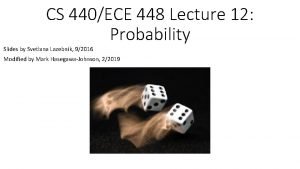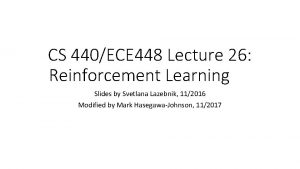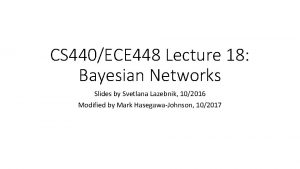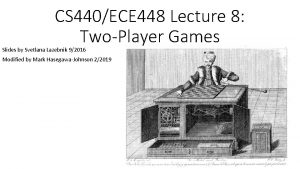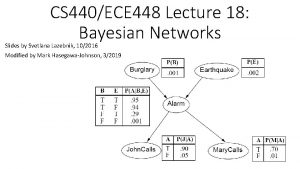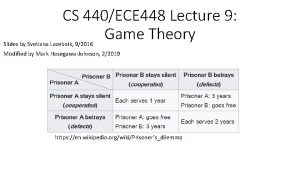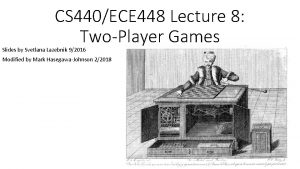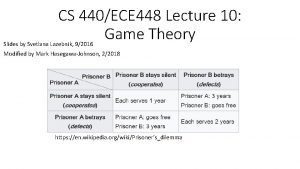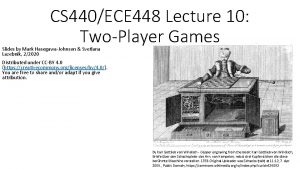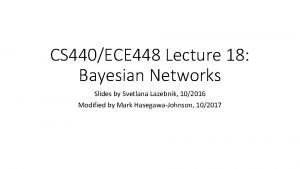CS 440ECE 448 Lecture 5 Search Order Slides

























































- Slides: 57

CS 440/ECE 448 Lecture 5: Search Order Slides by Svetlana Lazebnik, 9/2016 Revised by Mark Hasegawa-Johnson, 1/2018

Prioritized Search • Review: Tree Search vs. Dijkstra’s Algorithm • Criteria for evaluating a search algorithm: completeness, optimality, computational cost, storage cost • Search algorithms without side information: BFS, DFS, IDS, UCS • Search algorithms with side information: GBFS vs. A* • • • Heuristics to guide search Greedy best-first search A* search Admissible vs. Consistent heuristics Designing heuristics: Relaxed problem, Sub-problem, Dominance, Max

Dijkstra’s Shortest Path Algorithm •

Dijkstra Algorithm Complexity •

Tree Search Algorithm •

Tree Search Algorithm •

Prioritized Search • Review: Tree Search vs. Dijkstra’s Algorithm • Criteria for evaluating a search algorithm: completeness, optimality, computational cost, storage cost • Search algorithms without side information: BFS, DFS, IDS, UCS • Search algorithms with side information: GBFS vs. A* • • • Heuristics to guide search Greedy best-first search A* search Admissible vs. Consistent heuristics Designing heuristics: Relaxed problem, Sub-problem, Dominance, Max

Analysis of search strategies • Strategies are evaluated along the following criteria: • Completeness: does it always find a solution if one exists? • Optimality: does it always find a least-cost solution? • Time complexity: number of nodes generated • Space complexity: maximum number of nodes in memory • Time and space complexity are measured in terms of • b: maximum branching factor of the search tree • d: depth of the optimal solution • m: maximum length of any path in the state space (may be infinite)

Prioritized Search • Review: Tree Search vs. Dijkstra’s Algorithm • Criteria for evaluating a search algorithm: completeness, optimality, computational cost, storage cost • Search algorithms without side information: BFS, DFS, IDS, UCS • Search algorithms with side information: GBFS vs. A* • • • Heuristics to guide search Greedy best-first search A* search Admissible vs. Consistent heuristics Designing heuristics: Relaxed problem, Sub-problem, Dominance, Max

Depth-first search • Expand deepest unexpanded node • Implementation: frontier is a LIFO queue Example state space graph for a tiny search problem

Depth-first search Expansion order: (s, d, b, a, c, a, e, h, p, q, r, f, c, a, G)

Properties of depth-first search • Complete? (always finds a solution if one exists? ) Fails in infinite-depth spaces, spaces with loops Modify to avoid repeated states along path complete in finite spaces • Optimal? (always finds an optimal solution? ) No – returns the first solution it finds • Time? (how long does it take, in terms of b, d, m? ) Could be the time to reach a solution at maximum depth m: O(bm) Terrible if m is much larger than d But if there are lots of solutions, may be much faster than BFS • Space? (how much storage space, in terms of b, d, m? ) O(bm), i. e. , linear space!

http: //xkcd. com/761/

Breadth-first search • Expand shallowest unexpanded node • Implementation: frontier is a FIFO queue Example from P. Abbeel and D. Klein

Breadth-first search Expansion order: (s, d, e, p, b, c, e, h, r, q, a, a, h, r, p, q, f, q, c, G)

Properties of breadth-first search • Complete? Yes (if branching factor b is finite). Even w/o repeated-state checking, it still works. • Optimal? Yes – if cost = 1 per step (uniform cost search will fix this) • Time? Number of nodes in a b-ary tree of depth d: O(bd) (d is the depth of the optimal solution) • Space? O(bd) • Space is the bigger problem (more than time)

Iterative deepening search • Use DFS as a subroutine 1. 2. 3. 4. Check the root Do a DFS searching for a path of length 1 If there is no path of length 1, do a DFS searching for a path of length 2 If there is no path of length 2, do a DFS searching for a path of length 3…

Iterative deepening search

Iterative deepening search

Iterative deepening search

Iterative deepening search

Properties of iterative deepening search •

Search with varying step costs • BFS finds the path with the fewest steps, but does not always find the cheapest path

Uniform-cost search • For each frontier node, save the total cost of the path from the initial state to that node • Expand the frontier node with the lowest path cost • Implementation: frontier is a priority queue ordered by path cost • Equivalent to breadth-first if step costs all equal • Equivalent to Dijkstra’s algorithm, if Dijkstra’s algorithm is modified so that a node’s value is computed only when it becomes nonzero

Uniform-cost search example

Uniform-cost search example Expansion order: (s, p(1), d(3), b(4), e(5), r(7), f(8) e(9), G(10))

Properties of uniform-cost search • Complete? Yes, if step cost is greater than some positive constant ε (we don’t want infinite sequences of steps that have a finite total cost) • Optimal? Yes

Prioritized Search • Review: Tree Search vs. Dijkstra’s Algorithm • Criteria for evaluating a search algorithm: completeness, optimality, computational cost, storage cost • Search algorithms without side information: BFS, DFS, IDS, UCS • Search algorithms with side information: GBFS vs. A* • • • Heuristics to guide search Greedy best-first search A* search Admissible vs. Consistent heuristics Designing heuristics: Relaxed problem, Sub-problem, Dominance, Max

Informed search strategies • Idea: give the algorithm “hints” about the desirability of different states • Use an evaluation function to rank nodes and select the most promising one for expansion • Greedy best-first search • A* search

Heuristic function • = node we’re currently expanding • Most obvious thing to do: go toward the goal, i. e. , Start state Goal state

Heuristic function • Start state Goal state

Greedy best-first search Expand the node that has the lowest value of the heuristic function h(n)

Greedy best-first search Start state Goal state

Greedy best-first search Start state Goal state

Greedy best-first search Start state Goal state

Greedy best-first search Start state Goal state

Greedy best-first search Start state Goal state

Greedy best-first search Start state Goal state

Properties of greedy best-first search • Complete? No – can get stuck in loops • Optimal? No • Time? Worst case: O(bm) Can be much better with a good heuristic • Space? Worst case: O(bm)

How can we fix the greedy problem?

A* search • Idea: avoid expanding paths that are already expensive • The evaluation function f(n) is the estimated total cost of the path through node n to the goal: f(n) = g(n) + h(n) g(n): cost so far to reach n (path cost) h(n): estimated cost from n to goal (heuristic)

BFS vs. A* search Source: Wikipedia

Admissible heuristics • An admissible heuristic never overestimates the cost to reach the goal • A heuristic h(n) is admissible if for every node n, h(n) ≤ h*(n), where h*(n) is the true cost to reach the goal state from n • Example: • straight line distance never overestimates the actual road distance • Manhattan distance never overestimates actual road distance if all roads are on a Manhattan grid • Theorem: If h(n) is admissible, and if we don’t do repeated-state detection, then A* is optimal

Optimality of A* • Theorem: If h(n) is admissible, A* is optimal (if we don’t do repeated state detection) • Proof sketch: • A* expands all nodes for which f(n) ≤ C*, i. e. , the estimated path cost to the goal is less than or equal to the actual path cost to the first goal encountered • When we reach the goal node, all the other nodes remaining on the frontier have estimated path costs to the goal that are at least as big as C* • Because we are using an admissible heuristic, the true path costs to the goal for these nodes cannot be less than C*

A* gone wrong? Source: Berkeley CS 188 x

Consistency of heuristics h=4 Source: Berkeley CS 188 x

Optimality of A* • Tree search (i. e. , search without repeated state detection): • A* is optimal if heuristic is admissible (and non-negative) • Graph search (i. e. , search with repeated state detection) • A* optimal if heuristic is consistent �� • Consistency implies admissibility • In general, most natural admissible heuristics tend to be consistent, especially if from relaxed problems Source: Berkeley CS 188 x

Optimality of A* • A* is optimally efficient – no other tree-based algorithm that uses the same heuristic can expand fewer nodes and still be guaranteed to find the optimal solution • Any algorithm that does not expand all nodes with f(n) ≤ C* risks missing the optimal solution

Properties of A* • Complete? Yes – unless there are infinitely many nodes with f(n) ≤ C* • Optimal? Yes • Time? Number of nodes for which f(n) ≤ C* (exponential) • Space? Exponential

Prioritized Search • Review: Tree Search vs. Dijkstra’s Algorithm • Criteria for evaluating a search algorithm: completeness, optimality, computational cost, storage cost • Search algorithms without side information: BFS, DFS, IDS, UCS • Search algorithms with side information: GBFS vs. A* • • • Heuristics to guide search Greedy best-first search A* search Admissible vs. Consistent heuristics Designing heuristics: Relaxed problem, Sub-problem, Dominance, Max

Designing heuristic functions • Heuristics for the 8 -puzzle h 1(n) = number of misplaced tiles h 2(n) = total Manhattan distance (number of squares from desired location of each tile) h 1(start) = 8 h 2(start) = 3+1+2+2+2+3+3+2 = 18 • Are h 1 and h 2 admissible?

Heuristics from relaxed problems • A problem with fewer restrictions on the actions is called a relaxed problem • The cost of an optimal solution to a relaxed problem is an admissible heuristic for the original problem • If the rules of the 8 -puzzle are relaxed so that a tile can move anywhere, then h 1(n) gives the shortest solution • If the rules are relaxed so that a tile can move to any adjacent square, then h 2(n) gives the shortest solution

Heuristics from subproblems • Let h 3(n) be the cost of getting a subset of tiles (say, 1, 2, 3, 4) into their correct positions • Can precompute and save the exact solution cost for every possible subproblem instance – pattern database

Dominance • If h 1 and h 2 are both admissible heuristics and h 2(n) ≥ h 1(n) for all n, (both admissible) then h 2 dominates h 1 • Which one is better for search? • A* search expands every node with f(n) < C* or h(n) < C* – g(n) • Therefore, A* search with h 1 will expand more nodes

Dominance • Typical search costs for the 8 -puzzle (average number of nodes expanded for different solution depths): • d=12 IDS = 3, 644, 035 nodes A*(h 1) = 227 nodes A*(h 2) = 73 nodes • d=24 IDS ≈ 54, 000, 000 nodes A*(h 1) = 39, 135 nodes A*(h 2) = 1, 641 nodes

Combining heuristics • Suppose we have a collection of admissible heuristics h 1(n), h 2(n), …, hm(n), but none of them dominates the others • How can we combine them? h(n) = max{h 1(n), h 2(n), …, hm(n)}

All search strategies Algorithm Complete? Optimal? Time complexity Space complexity Implement the Frontier as a… BFS Yes If all step costs are equal O(b^d) Queue DFS No No O(b^m) O(bm) Stack IDS Yes If all step costs are equal O(b^d) O(bd) Stack Yes Number of nodes w/ g(n) ≤ C* Priority Queue sorted by g(n) No Worst case: O(b^m) Best case: O(bd) Worse case: O(b^m) Best case: O(bd) Priority Queue sorted by h(n) Yes Number of nodes w/ g(n)+h(n) ≤ C* Priority Queue sorted by h(n)+g(n) UCS Greedy A* Yes No Yes
 Via optica
Via optica A small child slides down the four frictionless slides
A small child slides down the four frictionless slides A child is on a playground swing motionless
A child is on a playground swing motionless Principles of economics powerpoint lecture slides
Principles of economics powerpoint lecture slides Machine learning course slides
Machine learning course slides Business communication lecture slides
Business communication lecture slides 01:640:244 lecture notes - lecture 15: plat, idah, farad
01:640:244 lecture notes - lecture 15: plat, idah, farad 448 scmw
448 scmw Jest głównym dopływem wisły ma 448 km długości
Jest głównym dopływem wisły ma 448 km długości Cs 448
Cs 448 Info 448
Info 448 500 - 448
500 - 448 Ece 448
Ece 448 Ece448
Ece448 Ece 448
Ece 448 Cs 448
Cs 448 Factors of 448
Factors of 448 Ece 448
Ece 448 Ece 448
Ece 448 Ece 448
Ece 448 Comparison of uninformed search strategies
Comparison of uninformed search strategies Unified search vs federated search
Unified search vs federated search Local search vs global search
Local search vs global search Federated search vs distributed search
Federated search vs distributed search Informed search and uninformed search
Informed search and uninformed search Mail @ malaysia.images.search.yahoo.com
Mail @ malaysia.images.search.yahoo.com Best first search in ai
Best first search in ai Blind search adalah
Blind search adalah Video.search.yahoo.com
Video.search.yahoo.com Searchyahoo
Searchyahoo Disadvantages of linear search
Disadvantages of linear search Linear search vs binary search
Linear search vs binary search Tw yahoo mail
Tw yahoo mail Cognitive search engine
Cognitive search engine Which search strategy is called as blind search
Which search strategy is called as blind search Http://search.yahoo.com/search?ei=utf-8
Http://search.yahoo.com/search?ei=utf-8 The search for order in an era of limits
The search for order in an era of limits Inverted complex sentence
Inverted complex sentence First and second order change in education
First and second order change in education Personal selling techniques
Personal selling techniques Explain law of mass action
Explain law of mass action Zero order kinetics
Zero order kinetics Law is order and good law is good order
Law is order and good law is good order Order properties
Order properties In order issue in order completion example
In order issue in order completion example Superscalar architecture diagram
Superscalar architecture diagram Arbol in order post order
Arbol in order post order First order cybernetics and second order cybernetics
First order cybernetics and second order cybernetics Estranha moral slides
Estranha moral slides Architecture runway slides
Architecture runway slides Verbos direcionais em libras
Verbos direcionais em libras Slides mania.com
Slides mania.com Splat google slides
Splat google slides Castro slides
Castro slides Uipath enterprise rpa platform
Uipath enterprise rpa platform Josh starmer
Josh starmer Data mining slides
Data mining slides Teoria de callista roy slides
Teoria de callista roy slides









